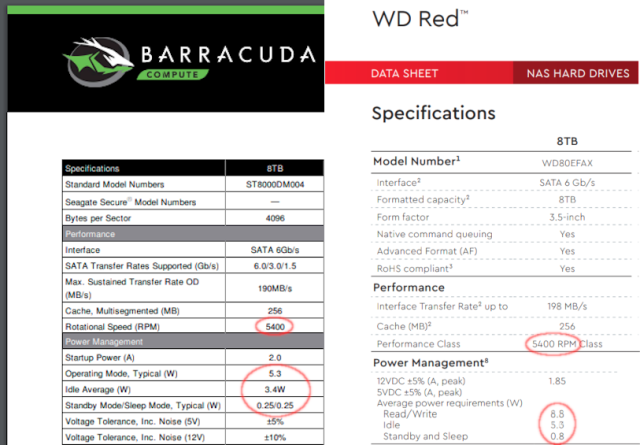-
Redditor /u/Amaroko placed this WD Blue drive on an empty cardboard box, and held a Blue Yeti mic just above it while it powered on. Spectral analysis of the audio shows a 90Hz baseline—90 cycles (revs) per second and 60 seconds per minute works out to 5,400RPM.
-
This WD Elements 8TB drive is listed as "5400 RPM Class" on its datasheet, and its firmware reports 5400 RPM via SMART—but it's humming at 120HZ. 120Hz * 60 secs/min = 7,200 RPM.
-
This WD MyBook 8TB drive also reports itself via SMART as spinning at 5,400RPM, but spectral audio analysis demonstrates a 120Hz (7200RPM) rotational speed.
Last week, the fine Redditors of /r/DataHoarder got upset with Western Digital again—this time, for misrepresenting the rotational speed of their WD Red Network Attached Storage hard drives. (Although the linked post brings things to a head, members of the German-language forum hardwareluxx.de began investigating the issue more than year ago.)
We found this controversy reminiscent of earlier complaints that Western Digital was not properly disclosing use of Shingled Magnetic Recording technology in their NAS drives. But the new complaint is that Western Digital calls 7200RPM drives "5400 RPM Class"—and the drives' own firmware report 5400 RPM via the SMART interface.Recently, redditor /u/Amaroko set out to prove or disprove earlier netizens' findings. For each of several drive models, Amoroko placed a sample of that drive on an empty cardboard box, with a Blue Yeti mic held directly above it, then powered the drive on. Spectral analysis of the recorded audio using Adobe Audition showed a baseline frequency of 120Hz for two models of WD 8TB "5400 RPM class" drive.
120 cycles/sec multiplied to 60 secs/min comes to 7,200 cycles/min. So in other words, these "5400 RPM class" drives really were spinning at 7,200rpm.
Who doesn’t want faster rotational speed?

At first blush, this might seem like a non-issue—who wouldn't prefer a drive with a faster spindle speed? Unfortunately, faster spindles don't just mean potentially lower seek latency—they also come with a sharp increase in both noise generation and power consumption.
That increase in noise and power is what got many users on the trail of Western Digital's fake 5,400rpm spindle speed in the first place—those users purchased drives which they expected to roll low and slow, but they got more noise, heat, and power consumption than they expected.
Comparing the data sheets between a 5,400rpm Seagate Barracuda and a "5400 RPM Class" Western Digital Red—which, as tested by audio spectral analysis, actually spins at 7,200rpm—we can see a clear difference in power consumption. The 8TB Red consumes 8.8W to the Barracuda's 5.3W when active, and 800mW to the Barracuda's 250mW when in standby mode. The difference here isn't, for the most part, the brand—when they're spinning at the same actual RPMs, Western Digital's and Seagate's drives consume roughly the same power.
To be fair to Western Digital, you can't actually buy an 8TB NAS drive that spins at 5,400RPM at all—both WD's Red and Seagate's Ironwolf entry-level NAS lineup use 7,200rpm spindles. But to be fair to the consuming public, "RPM" has a very specific meaning, and there isn't so much as a footnote on the WD Red datasheet to explain what—if anything—"5400 RPM performance class" actually means.
Western Digital’s response
When we reached out to Western Digital in the course of researching this story, a representative confirmed the various forum-goers' and Redditor's conclusions—that is to say, "5400 RPM class" does not actually mean that a drive spins at 5,400rpm.
For select products, Western Digital has published RPM speed within a “class” or “performance class” for numerous years rather than publishing specific spindle speeds. We also fine-tune select hard drive platforms and the related HDD characteristics to create several different variations of such platforms to meet different market or application needs. By doing so, we are able to leverage our economies of scale and pass along those savings to our customers. As with every Western Digital product, our product details, which include power, acoustics and performance (data transfer rate), are tested to meet the specifications provided on the product’s data sheet and marketing collateral.
In our editorial opinion, this response, however polished, is not helpful—and neither is the still-undefined "RPM class" itself. A consumer reading this data sheet will be more confused by the marketing fluff, not less. And the "typical consumers" who Western Digital might conceivably be trying to shield from information they don't understand are unlikely to be reading hard drive data sheets in the first place.
If you'll pardon an automotive analogy, this doesn't strike us as much different than a window sticker on a V6 sedan which declares it to be "four cylinder class," with no indication of what's actually under the hood.
Listing image by Brian Wong / Flickr
reader comments
358